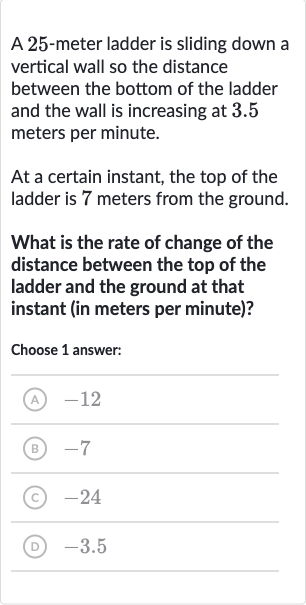AI tutor
Welcome to Bytelearn!
Let’s check out your problem:

A -meter ladder is sliding down a vertical wall so the distance between the bottom of the ladder and the wall is increasing at . meters per minute.At a certain instant, the top of the ladder is meters from the ground.What is the rate of change of the distance between the top of the ladder and the ground at that instant (in meters per minute)?Choose answer:(A) (B) (C) (D) .
Full solution
Q. A -meter ladder is sliding down a vertical wall so the distance between the bottom of the ladder and the wall is increasing at . meters per minute.At a certain instant, the top of the ladder is meters from the ground.What is the rate of change of the distance between the top of the ladder and the ground at that instant (in meters per minute)?Choose answer:(A) (B) (C) (D) .
- Given Information: We know the ladder's length is meters and the bottom is moving away from the wall at meters per minute. The top is meters from the ground.
- Pythagoras' Theorem: Let's use Pythagoras' theorem to find the distance of the bottom of the ladder from the wall. We have the ladder's length (hypotenuse) and the distance from the top of the ladder to the ground (one of the legs).
- Calculation: So, . That means .
- Finding Bottom Distance: Calculating that gives us , which is .
- Using Related Rates: Taking the square root of both sides, we get meters.
- Using Related Rates: Taking the square root of both sides, we get .Now, we'll use related rates to find the rate at which the top of the ladder is moving down. We differentiate both sides of the equation with respect to time .
- Using Related Rates: Taking the square root of both sides, we get meters.Now, we'll use related rates to find the rate at which the top of the ladder is moving down. We differentiate both sides of the equation with respect to time .Differentiating, we get .
More problems from Calculate unit rates with fractions
QuestionGet tutor help
QuestionGet tutor help
QuestionGet tutor help
QuestionGet tutor help
QuestionGet tutor help
QuestionGet tutor help
QuestionGet tutor help
QuestionGet tutor help
QuestionGet tutor help
